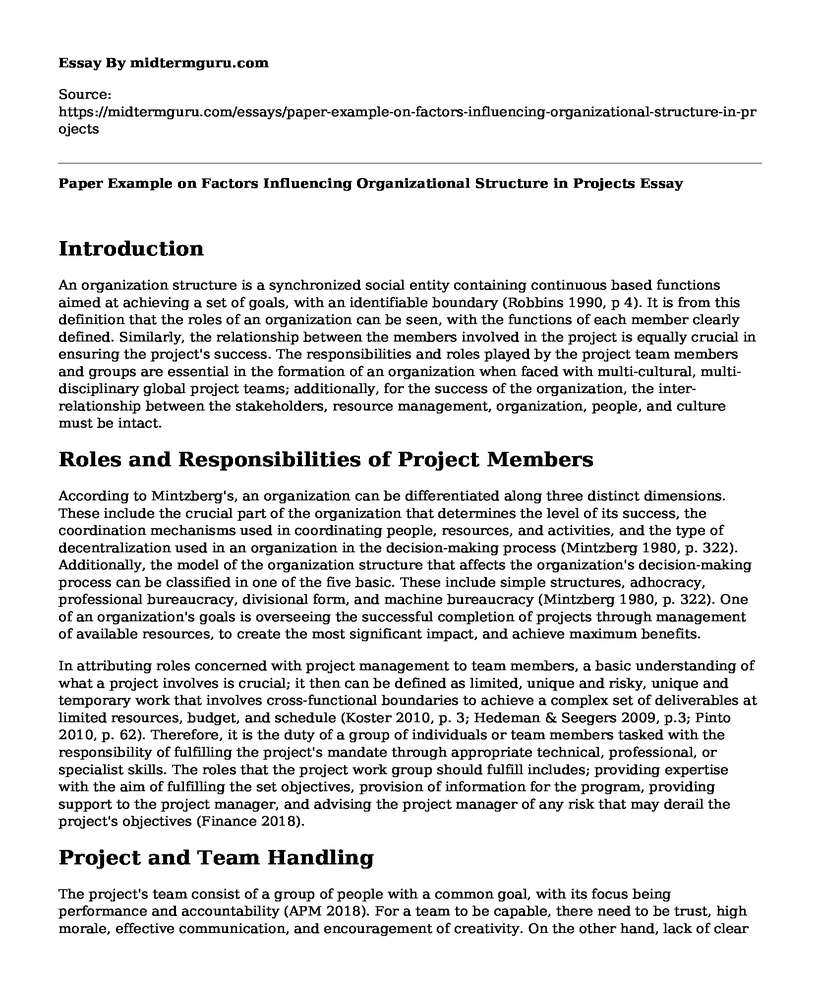Introduction
An organization structure is a synchronized social entity containing continuous based functions aimed at achieving a set of goals, with an identifiable boundary (Robbins 1990, p 4). It is from this definition that the roles of an organization can be seen, with the functions of each member clearly defined. Similarly, the relationship between the members involved in the project is equally crucial in ensuring the project's success. The responsibilities and roles played by the project team members and groups are essential in the formation of an organization when faced with multi-cultural, multi-disciplinary global project teams; additionally, for the success of the organization, the inter-relationship between the stakeholders, resource management, organization, people, and culture must be intact.
Roles and Responsibilities of Project Members
According to Mintzberg's, an organization can be differentiated along three distinct dimensions. These include the crucial part of the organization that determines the level of its success, the coordination mechanisms used in coordinating people, resources, and activities, and the type of decentralization used in an organization in the decision-making process (Mintzberg 1980, p. 322). Additionally, the model of the organization structure that affects the organization's decision-making process can be classified in one of the five basic. These include simple structures, adhocracy, professional bureaucracy, divisional form, and machine bureaucracy (Mintzberg 1980, p. 322). One of an organization's goals is overseeing the successful completion of projects through management of available resources, to create the most significant impact, and achieve maximum benefits.
In attributing roles concerned with project management to team members, a basic understanding of what a project involves is crucial; it then can be defined as limited, unique and risky, unique and temporary work that involves cross-functional boundaries to achieve a complex set of deliverables at limited resources, budget, and schedule (Koster 2010, p. 3; Hedeman & Seegers 2009, p.3; Pinto 2010, p. 62). Therefore, it is the duty of a group of individuals or team members tasked with the responsibility of fulfilling the project's mandate through appropriate technical, professional, or specialist skills. The roles that the project work group should fulfill includes; providing expertise with the aim of fulfilling the set objectives, provision of information for the program, providing support to the project manager, and advising the project manager of any risk that may derail the project's objectives (Finance 2018).
Project and Team Handling
The project's team consist of a group of people with a common goal, with its focus being performance and accountability (APM 2018). For a team to be capable, there need to be trust, high morale, effective communication, and encouragement of creativity. On the other hand, lack of clear objectives, proper structure, leadership, and commitment hinders the effectiveness of a team. The challenges faced by a multi-disciplinary, multi-cultural and global project teams include conflict management and resolution. Conflict refers to different attributes and objectives between team members, while conflict management refers to the identifying and resolving differences which if left unresolved, would derail the goals (APM 2018). Conflict varies with norms, project vision, culture and values, its absence is detrimental as it leads to time pressure, problems oversight, and self-doubt.
Inter-relationship Between the Organization and the Stakeholders
The organization's relationship with individuals follows a multi-dimensional relationship between its norms and culture, and the external and internal stakeholders' nature and personality. The organization's culture which involves the principles, practices, and traditions influencing its members, defines the relationship between managers and stakeholders (Dwivedi 1995, p.9). The enhancement of a relationship works through creating engagement through inclusiveness, mutual respect, infirmity diversity, and integrity. However, the organization's culture should try as much as possible to align themselves with the culture it is situated. The personality and beliefs of individuals through art, morals, custom, and knowledge needs integrating into the organization's work structure. Mastery of cultural integration enables a workplace to improve stakeholder's relations, better decision making, and better conflict management.
Conclusion
The roles and responsibilities of team members need to be concise and target the organization's goals and objectives. For it to occur, there need to be good team handling, with excellent conflict management and resolution, and improvement and alignment of the organization's relationship between itself and both the external and internal stakeholders. These are the factors that influence and determine the success of an organization project.
References
APM, 2018. How to deal with conflict constructively | APM. Available from: https://www.apm.org.uk/blog/how-to-deal-with-conflict-constructively-on-your-team/ [21 Nov. 2018].
Apm, 2018, Teamwork | APM. Available from: https://www.apm.org.uk/body-of-knowledge/people/interpersonal-skills/teamwork/ [21 Nov. 2018].
Dwivedi, R, 1990, Organizational culture and performance. New Delhi: State Mutual Book and Periodical Service.
Finance, 2018, Roles and responsibilities of the Programme or Project Team | Department of Finance. Available from: https://www.finance-ni.gov.uk/articles/roles-and-responsibilities-programme-or-project-team [21 Nov. 2018].
Hedeman, B. and Seegers, R., 2009. PRINCE2TM 2009 Edition-A Pocket Guide. Van Haren.
Mintzberg, H., 1980. Structure in 5's: A Synthesis of the Research on Organization Design. Management science, vol. 26, no. 3, pp.322-341.
Koster, K., 2009. International project management. Cornwall: Sage.
Pinto, J.K., 2010. Project Management: Achieving Competitive Advantage. New York: Pearson.
Robbins, S.P., 1990. Organization Theory: Structures, Designs, and Applications, 3/e. New Delhi: Pearson Education India.
Cite this page
Paper Example on Factors Influencing Organizational Structure in Projects. (2022, Oct 05). Retrieved from https://midtermguru.com/essays/paper-example-on-factors-influencing-organizational-structure-in-projects
If you are the original author of this essay and no longer wish to have it published on the midtermguru.com website, please click below to request its removal:
- Potential Gains and Losses - Essay Sample
- Essay on Discretionary Planning in UK Housing
- The Quality and Safety Education for Nurses (QSEN) - Paper Example
- Forecasting Case Study Paper Example: Urban Planning
- Questions and Answers on Benchmarking - Paper Example
- Essay Sample on Impact of Stress Management on Health
- Respect: Admiration & Awe for Unique Qualities & Abilities - Essay Sample







